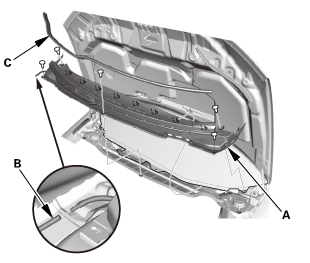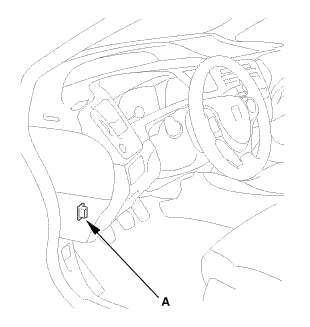Honda Civic Service Manual: Cylinder Head Inspection for Warpage (R18A9)

| 1. | Fuel Pressure - Relieving (Between the engine and the manual shut-off valve) (Natural Gas Model) |
|
|
Compressed natural gas is flammable and highly explosive. You could be
killed or seriously injured if leaking natural gas is ignited.
|
| 2. | Vehicle Lift |
|
| 3. | Tire and Wheel-Removal, Front Right |
|
|
|
| 4. | Battery Terminal - Disconnection |
|
|
|
|||||||||||||||||||||||||||
| 5. | Battery |
|
|
|
| 6. | Engine Cover |
|
|
|
| 7. | Radiator Cap |
|
| 8. | Radiator Coolant - Replacement |
|
|
|
| 9. | Intake Air Pipe |
|
|
|
| 10. | Air Cleaner |
|
|
|
| 11. | Wiper Arm Assembly |
|
|
|
| 12. | Both Side Cowl Covers |
|
|
|
| 13. | Center Cowl Cover |
|
|
|
| 14. | Under Cowl Panel |
|
|
|
| 15. | Fuel Feed Hose (Natural Gas Model) |
|
|
|
| 16. | Intake Air Duct |
|
|
|
| 17. | Throttle Body - Remove (Natural Gas Model) |
|
|
|
| 18. | Intake Manifold Assembly (Natural Gas Model) |
|
|
|
|
|
|
|
|
|
|
|
|
|
|
|
| 19. | Cylinder Head Peripheral Assembly |
|
|
|
|
|
|
|
|
|
|
|
|
| 20. | Ignition Coil |
|
|
|
| 21. | A/F Sensor (Sensor 1) |
|
|
|
| 22. | Exhaust Chamber Cover |
|
|
|
| 23. | Exhaust Chamber Cover (Natural Gas Model) |
|
|
|
| 24. | Splash Shield |
|
1. |
Remove the splash shield (A). |

| 25. | Engine Undercover |
|
|
|
| 26. | Secondary HO2S |
|
|
|
| 27. | Exhaust Pipe A (Except CVT) |
|
|
|
| 28. | Catalytic Converter (Natural Gas Model) |
|
|
|
| 29. | Thermostat Housing Peripheral Assembly (Natural Gas Model) |
|
|
|
|
|
|
|
|
|
| 30. | Thermostat Housing (Natural Gas Model) |
|
|
|
| 31. | Water Pump Pulley Mounting Bolt - Loosen |
|
|
|
| 32. | Drive Belt |
|
|
|
| 33. | Alternator |
|
|
|
|
|
|
| 34. | Water Pump Pulley |
|
|
|
| 35. | Auto Tensioner Assembly |
|
|
|
| 36. | Cylinder Head Cover and/or Packing |
|
|
|
|
|
|
| 37. | Check The No.1 Piston at Top Dead Center (With Cam Chain Case/Oil Pump) |
|
|
|
| 38. | Crankshaft Pulley |
|
|
|
| 39. | Engine Jack Support (State Of A Low Vehicle) |
|
| 40. | Mounting Bracket, Engine Side |
|
|
|
| 41. | Engine Oil Pump Assembly |
|
|
|
|
|
|
| 42. | Cam Chain Auto-Tensioner |
|
|
|
||||||||||||
|
|
|
|
|
|
||||||||||||
|
|
|
| 43. | Cam Chain |
|
|
|
| 44. | Cylinder Head Assembly |
|
|
|

| 1. | Cylinder Head Inspection for Warpage |
|
1. |
Check the cylinder head for warpage. Measure along the edges, and three ways across the center. |
|||||||||
|
||||||||||
|
||||||||||
|
||||||||||
 snuigm
snuigm


| 1. | Set The Crankshaft To Top Dead Center |
|
|
|
| 2. | Cylinder Head Assembly |
|
|
|
|
|
|
|
|
|
|
|
|
||||||
| 3. | Cam Chain |
|
|
|
|
|
|
|
|
|
| 4. | Cam Chain Auto-Tensioner |
|
|
|
||||||
|
|
|
|
|
|
| 5. | Engine Oil Pump Assembly |
|
|
|
||||||||||||||||||||||||||
|
|
|
||||||||||||||
|
|
|
||||||||||||||||||||||||||||||
| 6. | Mounting Bracket, Engine Side |
|
|
|
| 7. | Engine Jack Support (State Of A Low Vehicle) |
|
| 8. | Transmission Mount Bracket Mounting Bolt - Loosen |
|
M/T
A/T
|
|
| 9. | Lower Torque Rod - Loosen |
|
|
|
| 10. | Side Engine Mount - Tighten |
|
|
|
| 11. | Transmission Mount Bracket Mounting Bolt - Tighten |
|
1. |
Tighten the transmission mount bracket mounting bolt and nuts. |
M/T
 i2mm
i2mm
A/T
 nz
nz
| 12. | Lower Torque Rod Mounting Bolt - Tighten |
|
|
|
| 13. | Crankshaft Pulley |
|
|
|
|
|
|
|
|
|
|||||||||||||
|
|
|
||||||||||
| 14. | Valve Clearance Adjustment |
|
|
|
|
2. |
Select the correct feeler gauge for the valve clearance you are going to check. |
|||||||||
|
||||||||||
 no!
no!
|
|
|
|
|
|
|||||||||||||||
|
|
|
|
|
|
|
|
|
| 15. | Cylinder Head Cover and/or Packing |
|
|
|
|||||||||||||||
|
|
|
||||||||||||||||||||
|
|
|
||||||||||||||||||||
|
|
|
| 16. | Auto Tensioner Assembly |
|
|
|
| 17. | Water Pump Pulley |
|
|
|
| 18. | Alternator |
|
|
|
|
|
|
| 19. | Drive Belt |
|
|
|
| 20. | Water Pump Pulley Mounting Bolt - Tighten |
|
|
|
| 21. | Thermostat Housing (Natural Gas Model) |
|
|
|
| 22. | Thermostat Housing Peripheral Assembly (Natural Gas Model) |
|
|
|
|
|
|
|
|
|
| 23. | Catalytic Converter (Natural Gas Model) |
|
|
|
| 24. | Exhaust Pipe A (Except CVT) |
|
|
|
| 25. | Secondary HO2S |
|
|
|
| 26. | Engine Undercover |
|
|
|
| 27. | Splash Shield |
|
1. |
Install the splash shield (A). |

| 28. | Exhaust Chamber Cover (Natural Gas Model) |
|
|
|
| 29. | Exhaust Chamber Cover |
|
|
|
| 30. | A/F Sensor (Sensor 1) |
|
|
|
| 31. | Ignition Coil |
|
|
|
| 32. | Cylinder Head Peripheral Assembly |
|
|
|
|
|
|
|
|
|
|
|
|
| 33. | Intake Manifold Assembly (Natural Gas Model) |
|
|
|
|
|
|
|
|
|
|
|
|
|
|
|
| 34. | Throttle Body - Install (Natural Gas Model) |
|
|
|
| 35. | Intake Air Duct |
|
|
|
| 36. | Fuel Feed Hose (Natural Gas Model) |
|
|
|
| 37. | Under Cowl Panel |
|
|
|
| 38. | Center Cowl Cover |
|
|
|
| 39. | Both Side Cowl Covers |
|
|
|
| 40. | Wiper Arm Assembly |
|
|
|
| 41. | Air Cleaner |
|
|
|
| 42. | Intake Air Pipe |
|
|
|
| 43. | Engine Cover |
|
|
|
| 44. | Battery |
|
|
|
||||||
| 45. | Battery Terminal - Reconnection |
|
|
|
|||||||||||||||||||
| 46. | Manual Shut-off Valve - Open (Natural Gas Model) |
|
|
|
| 47. | Fuel Supply System Leak - Inspection (Natural Gas Model) |
|
|
|
|
|
|
|
|
|
| 48. | Radiator Coolant - Replacement (Natural Gas Model) |
|
1. |
Follow the chart and pour coolant into the radiator up to the base of the filler neck. |
|||||||||||||||||||||||||||||||||||||
|
NOTE: |
||||||||||||||||||||||||||||||||||||||
|
||||||||||||||||||||||||||||||||||||||
|
||||||||||||||||||||||||||||||||||||||
|
*: When you want to winterize the coolant with the minimum amount of coolant change but the current coolant concentration in the vehicle is unknown, you must drain all coolant from the cooling system. |
||||||||||||||||||||||||||||||||||||||
|
||||||||||||||||||||||||||||||||||||||
|
||||||||||||||||||||||||||||||||||||||

| 49. | Tire and Wheel-Installation, Front Right |
|
|
|
||||||
| 50. | Warm Up The Engine |
|
| 51. | HDS DLC - Connection |
|
|
|
| 52. | Idle Speed - Inspection (Natural Gas Model) |
|
||||||||||||||||||||||||||||||||||||||||||||||
| 53. | CKP Pattern Clear/CKP Pattern Learn |
|
| 54. | Ignition Timing - Inspection |
|
|
|
|
|
|
||||||||||||||||
| 55. | Maintenance Minder Reset |
|
 Cylinder Head Inspection for Warpage (K24Z7)
Cylinder Head Inspection for Warpage (K24Z7)
1.
Vehicle Lift
1.
Raise the vehicle on a lift, and make sure it is securely supported.
2. ...
 Cylinder Head Removal and Installation (R18A9)
Cylinder Head Removal and Installation (R18A9)
1.
Fuel Pressure - Relieving (Between the engine and the manual shut-off
valve) (Natural Gas Model)
Compressed natural gas is flammable and ...
See also:
Honda Civic Owners Manual. Modifications
Do not modify your vehicle in a manner that may affect its handling,
stability, or
reliability, or install non-genuine Honda parts or accessories that may have a
similar
effect.
Even minor modifications to vehicle systems can affect overall vehicle
performance.
Always make sure all equ ...



 12x1mm
12x1mm











































 [av
[av










 inmmam
inmmam
 secounstep
secounstep

 ...,is(1.2
...,is(1.2
 nokvf-in.
nokvf-in.


 25mm(7(32k1n1omm12
25mm(7(32k1n1omm12
 125mmnminm.:125mm
125mmnminm.:125mm


 nxl.mm
nxl.mm


 o7jaanmo2oa
o7jaanmo2oa











 inl.25mmssn-m
inl.25mmssn-m mmn-m(2
mmn-m(2 i.nmm(n.i
i.nmm(n.i
 imm
imm


 :1mm.....
:1mm..... inmm125mm22i21
inmm125mm22i21







 mm
mm


 mmm.uimm
mmm.uimm
 22mm)2222
22mm)2222
 1.122
1.122






 mminmuan
mminmuan

